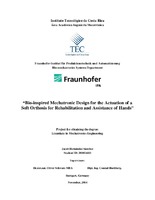Bio-inspired Mechatronic Design for the Actuation of a Soft Orthosis for Rehabilitation and Assistance of Hands
Resumen
It is described the design of a mechatronic system to actuate a hand soft orthotic device for rehabilitation and assistance purposes developed by the author of this thesis within the Bio Mechatronics Department of Fraunhofer Institute for Manufacturing Engineering and Automation (IPA) based in Stuttgart, Germany. The system mimics the musculoskeletal anatomy and kinesiology of the human body by resembling the bone-muscle-tendon configuration. A key feature of the orthosis is that allows the individual movement of the fingers. The actuation consists in the use of -high contraction- Festo Pneumatic Artificial Muscles (PAMs) within a 3D printed support structure which was designed using anthropometric data to aim to comfort and ergonomics. The PAMs are operated with piezoelectric -flow proportional- valves. The sensors mimic the human somatosensory system to control the motion and to confer a haptic nature to the human interface. The use of light indicators allows visual reinforcement during exercises. The final deliverable is a testing model that is going to be used for further experiments. Finally, this orthotic device is envisioned to become a mobile solution for self-aided rehabilitation.
Descripción
Proyecto de Graduación (Licenciatura en Ingeniería en Mecatrónica) Instituto Tecnológico de Costa Rica. Escuela de Ingeniería en Mecatrónica, 2010.


